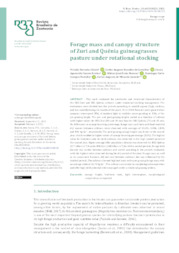Forage mass and canopy structure of Zuri and Quênia guineagrasses pasture under rotational stocking.
Forage mass and canopy structure of Zuri and Quênia guineagrasses pasture under rotational stocking.
Autoria: VALOTE, P. D.; CARVALHO, C. A. B. de; FREITAS, C. A. S.; MORENZ, M. J. F.; PACIULLO, D. S. C.; GOMIDE, C. A. de M.
Resumo: This work evaluated the productive and structural characteristics of the BRS Zuri and BRS Quênia cultivars under rotational stocking management. The evaluations were divided into five periods according to rainfall regime (high, medium, and low rainfall) during 16 months of the years 2016-2018. Pastures were grazed when canopies intercepted 95% of incident light to stubbles corresponding to 50% of the pre-grazing height. The pre- and post-grazing heights varied as a function of cultivar, with higher values for BRS Zuri (89 and 49 cm) than for BRS Quênia (78 and 45 cm). No differences in canopy lowering percentage, forage mass, and stem and dead material dry masses between cultivars were observed, with averages of 41.3%, 5,856, 1,835, and 841 kg ha?1, respectively. The post-grazing canopy height was lower in the second year, which resulted in higher values of canopy lowering percentage (51%). The highest value for leaf:stem ratio for both cultivars was observed in the high rainfall period of the second year. Higher average tiller population density was observed for BRS Quênia (477 tillers m?2) than for BRS Zuri (260 tillers m?2) for all the rainfall periods. Forage bulk density was similar between cultivars and varied according to the periods evaluated, with the highest value observed during the dry period of the year. Forage mass, as well as its component fractions, did not vary between cultivars, but was influenced by the studied periods. The cultivars showed high leaf mass in the pre-grazing forage mass with an average value of 3,174 kg ha?1. The cultivars are similar in morphological composition and offer high yield potential when managed under a rotational grazing system.
Ano de publicação: 2021
Tipo de publicação: Artigo de periódico
Unidade: Embrapa Gado de Leite
Palavras-chave: BRS Quênia, BRS Zuri, Capim, Forragem, Lotação rotativa, Pastejo Rotativo
Observações
1 - Por padrão são exibidas publicações dos últimos 20 anos. Para encontrar publicações mais antigas, configure o filtro ano de publicação, colocando o ano a partir do qual você deseja encontrar publicações. O filtro está na coluna da esquerda na busca acima.
2 - Para ler algumas publicações da Embrapa (apenas as que estão em formato ePub), é necessário ter, no celular ou computador, um desses softwares gratuitos. Sistemas Android: Google Play Livros; IOS: iBooks; Windows e Linux: software Calibre.
Acesse outras publicações
Acesse a Base de Dados da Pesquisa Agropecuária (BDPA) para consultar o acervo completo das bibliotecas da Embrapa.

